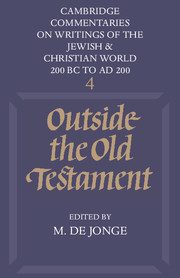Book contents
- Frontmatter
- Contents
- General Editors' Preface
- Editor's Foreword
- Acknowledgements
- Abbreviations
- General Introduction
- Pseudo-Philo, Liber Antiquitatum Biblicarum
- The Ethiopic Book of Enoch
- The Testament of Abraham
- The Testaments of the Twelve Patriarchs
- Joseph and Aseneth
- The Book of Jubilees
- The Testament (Assumption) of Moses
- The Psalms of Solomon
- The Martyrdom of Isaiah
- The Syriac Apocalypse of Baruch
- Paraleipomena Jeremiou
- The Testament of Job
- Index
General Introduction
Published online by Cambridge University Press: 05 June 2012
- Frontmatter
- Contents
- General Editors' Preface
- Editor's Foreword
- Acknowledgements
- Abbreviations
- General Introduction
- Pseudo-Philo, Liber Antiquitatum Biblicarum
- The Ethiopic Book of Enoch
- The Testament of Abraham
- The Testaments of the Twelve Patriarchs
- Joseph and Aseneth
- The Book of Jubilees
- The Testament (Assumption) of Moses
- The Psalms of Solomon
- The Martyrdom of Isaiah
- The Syriac Apocalypse of Baruch
- Paraleipomena Jeremiou
- The Testament of Job
- Index
Summary
The so-called Pseudepigrapha
In the companion volume to this series, The Jewish and Christian World 200 bc to ad 200, A. R. C. Leaney has given a short history of the origin of Law, Prophets and Writings as an authoritative Hebrew canon of Scripture. He has also pointed to the existence of the Apocrypha of the Greek and Latin Bible and of Pseudepigrapha, a term used to denote a number of writings, other than the canonical books and the apocrypha, that profess to give genuine information about important biblical figures and to convey, through them, teaching relevant to later generations.
The word ‘pseudepigraphon’, in the strict sense of ‘a writing with false superscription or title’ (Liddell–Scott–Jones, Greek-English Lexicon), can only be applied to a certain number of these writings. The Testament (Assumption) of Moses, for example, gives the last words of Moses (in a narrative setting) and the Testaments of the Twelve Patriarchs give the parting words of the sons of Jacob; the apocalypses 1 Enoch and 2 Baruch record visions seen by Enoch and Baruch, again in a narrative setting. But other narratives are in the first place narratives about biblical figures (so, for example, Joseph and Aseneth, the Martyrdom of Isaiah, the Paraleipomena Jeremiou and the Testament of Job) in which the words of the central figures function within the story about them. There, too, it is of course supposed that what they did and said is of the utmost importance for the readers in their own situation.
- Type
- Chapter
- Information
- Outside the Old Testament , pp. 1 - 5Publisher: Cambridge University PressPrint publication year: 1986



